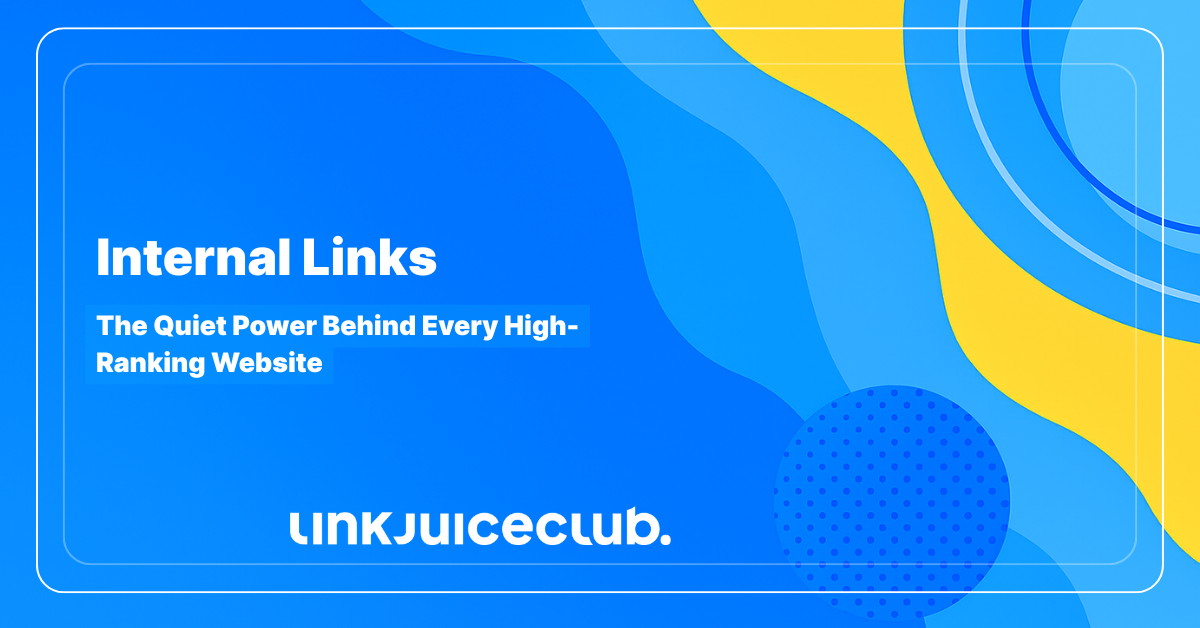
Internal Links: The Quiet Power Behind Every High-Ranking Website
Let’s call it what it is — internal links are the unsung heroes of SEO. Not flashy, not loud, but absolutely essential.
They don’t just guide users across your site — they guide Google too.
From navigation bars to embedded content links, each one shapes the way search engines crawl, understand, and prioritize your pages.
Use them carelessly, and you’re leaving rankings on the table.
Use them smartly, and you’re channeling link equity like a pro, turning every backlink into a booster for your whole domain.
This isn’t just site structure. This is strategy — and it starts from within.

Smart Linking: Best Practices to Master Internal Links
Before you scatter links like breadcrumbs, remember — internal linking isn’t about volume. It’s about precision.
Every link should have a purpose, a destination, and a reason to exist. This is how you build authority, flow relevance, and keep both users and crawlers moving exactly where you want them.
Let’s break down what separates smart internal linking from the mess most sites make.
Place Your Links Where Eyes Land First
Not all link placements are created equal. The higher up your internal links appear, the sooner they start working for you.
💥 Why it matters:
- Links near the top catch readers early — before attention drops
- Early clicks = longer sessions, lower bounce rates, stronger engagement signals
Even if Google isn’t directly using dwell time as a ranking factor (yet), it’s a solid signal of content quality — and user satisfaction.
Here’s the smarter play:
- Drop 1–2 internal links near the top, but not in the intro (unless ultra-relevant)
- Place your first link in the first main section — where it feels natural, not forced
- Make sure those early links deepen the journey, not derail it
🧭 Think of it this way: Your top-of-page link should feel like a helpful nudge, not an exit ramp.
Done right, it keeps readers hooked — and Google watching.
Anchor Like You Mean It: Use Keyword-Rich (But Natural) Phrases
Your anchor text is more than just clickable text — it’s a signal flare to both users and search engines.
✔️ It tells Google what the destination page is all about
✔️ It sets expectations for readers before they even click
But don’t just stuff it with keywords like it’s 2012.
Here’s the move:
- Use keyword-rich anchors — yes, even exact-match — but sparingly
- Mix things up with partial matches, synonyms, or even questions
- Keep it human: would someone actually click that text?
Example: Instead of always linking with “ecommerce SEO,” try:
- “optimize your store for search”
- “drive organic traffic to your ecommerce site”
- “SEO tips for online shops”
📌 The goal? Build contextual bridges that flow naturally and feed Google the right hints — without looking like you’re gaming the system.
Don’t Just Link To It — Link From It, Too
If you want your top pages to shine in Google’s eyes, don’t just throw links at them — make sure they’re giving back, too.
Think of your site like a city. Some streets (pages) get a lot of traffic. Others? Not so much. Internal links are the highways that send attention — and authority — where it’s needed most.
💡 Here’s how to shift link equity like an SEO architect:
- Open up your backlink tool (Semrush works like a charm)
- Head into the Backlink Analytics section
- Look under Indexed Pages to spot your heavy hitters — the ones with the most referring domains
- Now link from those pages to your priority content (the ones you want to rank faster)
Let’s say you just published a new post on “Google RankBrain.” It’s fresh, which means — no backlinks yet. But you do have older blog posts with dozens of high-quality referring domains.
✔️ Add keyword-rich links from those authoritative posts to your new one
✔️ Balance anchor text — natural, relevant, no copy-paste spam
✔️ Watch your new page climb the SERPs with less friction
One Anchor, One Destination: Keep Labels Unique
Think of anchor text like signposts. If two different roads have the same label, how’s anyone — or any crawler — supposed to know where they lead?
📉 Using identical anchor text for multiple pages muddies the waters.
Google sees two links with the same phrasing and assumes those pages are basically twins. Spoiler: that’s not good for rankings.
🧁 Let’s say you’ve got two killer recipes:
- One for vegan blueberry muffins
- Another for gluten-free blueberry muffins
If you keep linking to both with just “blueberry muffins” — Google gets confused.
So do your readers.
✅ Instead, be specific:
- “dairy-free blueberry muffin recipe”
- “wheat-free muffin for clean eating”
The clearer your anchors, the better Google understands what each page brings to the table. And that means stronger, sharper rankings for both.
Internal Links: Your Built-In Indexing Boost
Google’s pretty good at crawling — but it’s not omniscient.
If your site is big, deep, or freshly updated, some pages can slip through the cracks. That’s where smart internal linking becomes your indexing insurance policy.
📌 Why it works:
- It creates clear crawl paths to deep or hidden pages
- It connects orphan pages (with no links) back to the core of your site
- It makes important content easier for bots — and people — to discover
✅ Try this indexing method:
- Find under-indexed or low-traffic pages
- Add internal links from relevant, higher-traffic pages
- Include the page (or its parent category) in your main navigation if it’s critical
- Double-check it’s listed in your XML sitemap
Pages that stay hidden don’t get ranked. Internal links open the door.
Skip the Robots — Avoid Automated Internal Linking

Automation has its place in SEO — but internal linking isn’t one of them.
🧠 Why smart SEOs do it manually:
- Context matters: Tools don’t know which pages actually deserve links — or where to source them from
- Anchor overload: One misconfigured plugin can unleash thousands of identical anchor texts across your site. Not helpful. Definitely spammy.
- User experience gets sidelined: Internal links should guide humans to relevant content, not just satisfy algorithms
🔍 A good internal link feels natural. It supports the content around it. It adds value — not clutter.
So unless you want your blog posts to read like a keyword salad, stay in control. Craft your links with intent.
Make Your Homepage Pull Double Duty
Your homepage isn’t just a welcome mat — it’s your site’s most trusted voice in Google’s eyes.
That authority? It’s gold. And internal links from your homepage are how you spend it wisely.
🎯 Here’s how to link with intent:
- Prioritize key pages that need visibility or a rankings boost
- Highlight evergreen resources or cornerstone content in your homepage sections
- Use top-level navigation and featured blocks to guide users deeper into your funnel
💡 On the LJC blog, we use the homepage to spotlight our SEO playbooks, content frameworks, and most-read guides — giving these pages a direct injection of internal authority.
Think of it as building a flow of trust — from the strongest page to the ones you want to lift next.
Too Much of a Good Thing: Don’t Overdo Internal Links
Yes, internal links are powerful — but more doesn’t always mean better.
💡 Here’s the truth:
- The more links you stack on a page, the less weight each one carries
- Cramming in 50+ links dilutes authority and overwhelms the reader
- It’s not just about SEO — it’s about experience
So what’s the move?
✅ Be intentional.
Only include links that truly add value or help the reader take the next step. If it makes sense contextually and improves navigation, it deserves a spot — even if it doesn’t pass much SEO juice.
Think quality, not quantity. Guide the user, don’t flood them.
The Bottom Line: Make Internal Links Work For You
Internal linking isn’t just an SEO checkbox — it’s a strategy you build into your site structure, one click at a time.
Here’s your repeatable playbook:
- 🧠 Use keyword-rich anchors — but vary them to keep context clear
- 🔗 Link to and from your most valuable pages to direct authority where it counts
- 🚫 Never use the same anchor text for two different destinations — clarity wins
- 📍 Place important links near the top to boost engagement and lower bounce rates
- 🕸️ Help Google crawl deeper into your site by linking to pages that are buried or isolated
- 🏠 Use your homepage as a link hub — it’s your most authoritative page
- 🤖 Skip automation — internal links should feel intentional, not robotic
- 🎯 Don’t go overboard — prioritize links that genuinely serve the reader
Want to push your SEO even further?
Pair your internal linking strategy with strong link building and technical SEO practices. That’s how you create a site Google understands — and users love to navigate.
Ready to build authority from the inside out?





